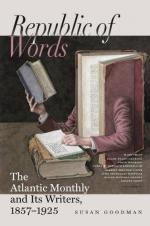The monument, upon the opposite side, to Julian, third son of Lorenzo Magnifico, is of very much the same character. Here are also two mourning figures. One is a sleeping and wonderfully beautiful female shape, colossal, in a position less adapted to repose than to the display of the sculptor’s power and her own perfections. This is Night. A stupendously sculptured male figure, in a reclining attitude, and exhibiting, I suppose, as much learning in his torso as does the famous figure in the Elgin marbles, strikes one as the most triumphant statue of modern times.
The figure of Julian is not agreeable. The neck, long and twisted, suggests an heroic ostrich in a Roman breastplate. The attitude, too, is ungraceful. The hero sits with his knees projecting beyond the perpendicular, so that his legs seem to be doubling under him, a position deficient in grace and dignity.
It is superfluous to say that the spectator must invent for himself the allegory which he may choose to see embodied in this stony trio. It is not enough to be told the words of the charade,—Julian, Night, Morning. One can never spell out the meaning by putting together the group with the aid of such a key. Night is Night, obviously, because she is asleep. For an equally profound reason, Day is Day, because he is not asleep; and both, looked at in this vulgar light, are creations as imaginative as Simon Snug, with his lantern, representing moonshine. If the figures should arise and walk across the chapel, changing places with the couple opposite them, as if in a sepulchral quadrille, would the allegory become more intelligible? Could not Day or Night move from Julian’s monument, and take up the same position at Lorenzo’s tomb, or “Ninny’s tomb,” or any other tomb? Was Lorenzo any more to Aurora than Julian, that she should weep for him only?
Therefore one must invent for one’s self the fable of those immortal groups. Each spectator must pluck out, unaided, the heart of their mystery. Those matchless colossal forms, which the foolish chroniclers of the time have baptized Night and Morning, speak an unknown language to the crowd. They are mute as Sphinx to souls which cannot supply the music and the poetry which fell from their marble lips upon the ear of him who created them.
X.
Palazzo Riccardi.
The ancient residence of Cosmo Vecchio and his successors is a magnificent example of that vast and terrible architecture peculiar to Florence. This has always been a city, not of streets, but of fortresses. Each block is one house, but a house of the size of a citadel; while the corridors and apartments are like casemates and bastions, so gloomy and savage is their expression. Ancient Florence, the city of the twelfth and beginning of the thirteenth centuries, the Florence of the nobles, the Florence of the Ghibellines, the Florence in which nearly every house was a castle,




